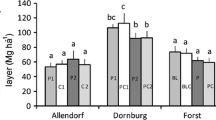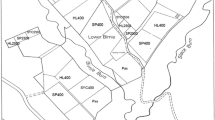Abstract
Carbon (C) sequestration potential was quantified for five tree species, commonly used in tree-based intercropping (TBI) and for conventional agricultural systems in southern Ontario, Canada. In the 25-year-old TBI system, hybrid poplar (Populus deltoides × Populus nigra clone DN-177), Norway spruce (Picae abies), red oak (Quercus rubra), black walnut (Juglans nigra), and white cedar (Thuja occidentalis) were intercropped with soybean (Glycine max). In the conventional agricultural system, soybean was grown as a sole crop. Above- and belowground tree C Content, soil organic C, soil respiration, litterfall and litter decomposition were quantified for each tree species in each system. Total C pools for hybrid poplar, white cedar, red oak, black walnut, Norway spruce and a soybean sole-cropping system were 113.4, 99.4, 99.2, 91.5, 91.3, and 71.1 t C ha−1, respectively at a tree density of 111 trees ha−1, including mean tree C content and soil organic C stocks. Net C flux for hybrid poplar, white cedar, red oak, black walnut, Norway spruce and soybean sole-crop were 2.1, 1.4, 0.8, 1.8, 1.6 and −1.2 t C ha−1 year−1, respectively. Results presented suggest greater atmospheric CO2 sequestration potential for all five tree species when compared to a conventional agricultural system.




Similar content being viewed by others
References
Anderson JM, Ingram JSI (eds) (1989) Tropical soil biology and fertility: a handbook of methods. C.A.B. International, Michigan
Bambrick AD, Whalen JK, Bradley RL, Cogliastro A, Gordon AM, Olivier A, Thevathasan NV (2010) Spatial heterogeneity of soil organic carbon in tree-based intercropping systems in Quebec and Ontario Canada. Agrofor Syst 79:343–353
Brady NC, Weil RR (1996) The nature and properties of soils. Prentice Hall, Upper Saddle River
Clinch RL, Thevathasan NV, Gordon AM, Volk TA, Sidders D (2009) Biophysical interactions in a short rotation willow intercropping system in southern Ontario, Canada. Agric Ecosyst Environ 131:31–39
Dixon RK (1995) Agroforestry systems: sources or sinks of greenhouse gases. Agrofor Syst 31:99–116
Edwards NT (1982) The use of soda-lime for measuring respiration rates in terrestrial systems. Pedobiologia 23:312–330
Gisi U (1997) Bodenökologie. 2. Auflage. Georg Thieme Verlag, Stuttgart, p 351
Gordon AM, Thevathasan NV (2005) How much carbon can be stored in Canadian agroecosystems using a silvopastoral approach? In: Mosquera-Losada MR, McAdam J, Rigueiro-Rodriguez A (eds) Silvopastoralism and sustainable land management, 1st edn. CABI Publishing, Wallingford, pp 210–217
Gray GRA (2000) Root distribution of hybrid polar in a temperate agroforestry intercropping system. M.Sc. Thesis. Department of Environmental Biology, University of Guelph, Guelph, Ontario, Canada
IPCC (2001) Climate change: Mitigation
IPCC (2013) Climate change: carbon and other biogeochemical cycles
Lee KH, Jose S (2003) Soil respiration and microbial biomass in a pecan-cotton alley cropping system in southern USA. Agrofor Syst 58:45–54
Matteucci G, Dore S, Stivanelllo S, Rebmann C, Buchmann N, Buchmann N (2000) Soil respiration in beech and spruce forests in Europe: trends, controlling factors, annual budgets and implications for the ecosystem carbon balance. In: Schulze ED (ed) Carbon and nitrogen cycling in European forest ecosystems. Ecological studies. Springer-Verlag, Berlin, pp 217–236-298
Mungai NW, Motavalli PP (2006) Litter quality effects on soil carbon and nitrogen dynamics in temperate alley cropping systems. Appl Soil Ecol 31:32–42
Oelbermann M (2002) Linking carbon inputs to sustainable agriculture in Canadian and Costa Rican agroforestry systems. Ph.D. Thesis. University of Guelph
Oelbermann M, Voroney RP, Gordon AM (2004) Carbon sequestration in tropical and temperate agroforestry systems: a review with examples from Costa Rica and southern Canada. Agric Ecosyst Environ 104:359–377
Peichl M, Thevathasan NV, Gordon AM, Huss J, Abohassan RA (2006) Carbon sequestration potentials in temperate tree-based intercropping systems, southern Ontario, Canada. Agrofor Syst 66:243–357
Ramnarine R, Voroney RP, Wagner-Riddle C, Dunfield KE (2011) Carbonate removal by acid fumigation for measuring the δ13 C of soil organic carbon. Can J Soil Sci 91:247–250
Sanderman J, Farquharson R, Baldock J (2009) Soil carbon sequestration potential: a review for Australian agriculture. Department of Climate Change and Energy Efficiency, CSIRO, Urrbrae
Simpson JA (1999) Effects of shade on maize and soybean productivity in a tree based intercrop system. M.Sc. University of Guelph, Guelph
Thevathasan NV, Gordon AM (1998) Poplar leaf biomass distribution and nitrogen dynamics in a poplar-barley intercropped system in southern Ontario, Canada. Agrofor Syst 37:79–90
Thevathasan NV, Gordon AM (2004) Ecology of tree intercropping systems in the north temperate region: experiences from southern Ontario, Canada. Agrofor Syst 61:257–268
Acknowledgments
First and foremost, we gratefully acknowledge the funding received to conduct this study through the Agricultural Greenhouse Gas Program (AGGP) administered by Agriculture and Agri-Food Canada (AAFC). We would also like to thank the faculty, staff and students at the Agroforestry Research Station. Special thanks to Idris Mohammed from the University of Guelph and Albérique de la Teyssonnière from AgroParisTech during field and lab work. Authors also thank Kira Borden from the University of Toronto for providing bulk density data and to Dr. Xiao-Bang Peng, visiting scientist from the ShangLuo University, China for providing soybean crop biomass data.
Author information
Authors and Affiliations
Corresponding author
Rights and permissions
About this article
Cite this article
Wotherspoon, A., Thevathasan, N.V., Gordon, A.M. et al. Carbon sequestration potential of five tree species in a 25-year-old temperate tree-based intercropping system in southern Ontario, Canada. Agroforest Syst 88, 631–643 (2014). https://doi.org/10.1007/s10457-014-9719-0
Received:
Accepted:
Published:
Issue Date:
DOI: https://doi.org/10.1007/s10457-014-9719-0




